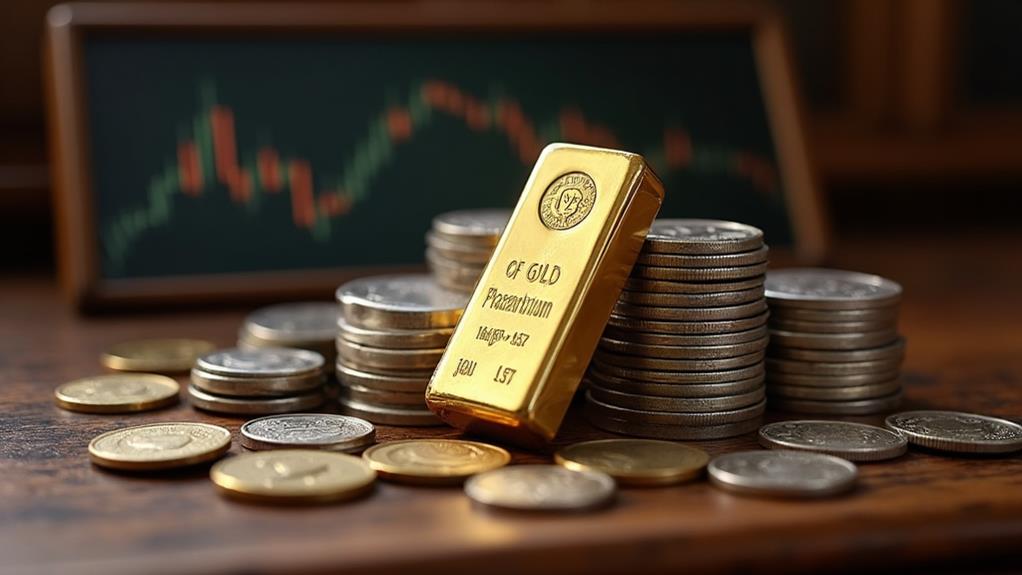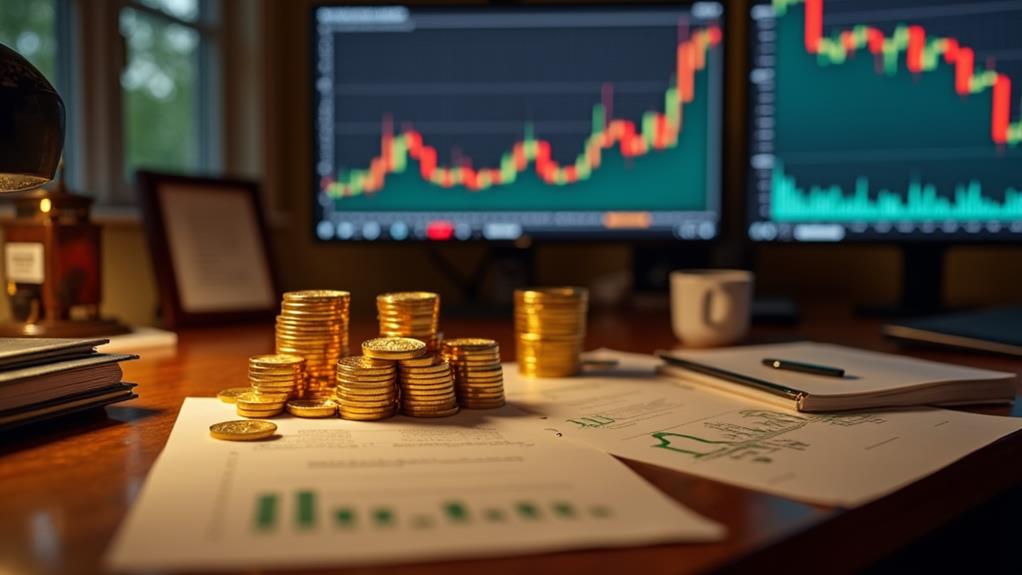Gold's enduring allure as a financial asset spans millennia, captivating investors and economists alike. From ancient civilizations to modern financial markets, this precious metal has maintained its status as a symbol of wealth and a safeguard against economic volatility. As global uncertainties persist and traditional investment vehicles face increasing scrutiny, gold's role in portfolio diversification and wealth preservation has gained renewed attention. Nevertheless, the landscape of gold investment has evolved significantly in recent years, presenting both opportunities and challenges for those seeking to harness its potential. The inquiry remains: how does gold's historical significance translate into its value in today's complex financial ecosystem?
Key Insights
- Gold has served as a symbol of wealth and store of value across civilizations for thousands of years.
- Gold provides portfolio diversification due to its low correlation with stocks and bonds, reducing overall risk.
- As a safe-haven asset, gold attracts investors during economic downturns and periods of uncertainty.
- Modern investment methods include gold ETFs, futures, digital platforms, mining stocks, and gold-backed cryptocurrencies.
- Gold's future outlook depends on economic instability, regulatory changes, technological innovations, and supply-demand dynamics.
Gold's Historical Significance

Gold, a timeless symbol of wealth and power, has played a vital role in human civilization for millennia. Throughout history, gold has been admired for its rarity, beauty, and durability, making it a prized possession in ancient civilizations.
From the Egyptians to the Incas, gold adorned tombs, temples, and royal treasuries, symbolizing divine power and earthly riches.
The history of gold as a symbol of wealth spans cultures and continents. In ancient Rome, gold coins became a standardized currency, facilitating trade and economic growth.
During the Middle Ages, alchemists sought to transmute base metals into gold, driven by its perceived value. The California Gold Rush of 1849 sparked a global migration, reshaping economies and societies.
Today, gold remains a store of value and a hedge against economic uncertainty, its historical significance continuing to influence modern investment strategies.
Understanding Gold as an Asset
Gold's role as an investment asset extends beyond its historical significance, encompassing its essential value, unique supply and demand dynamics, and function as a portfolio diversification tool.
As a tangible asset with limited supply, gold often maintains value during economic uncertainties, attracting investors seeking stability.
Nevertheless, potential investors should carefully consider gold's price volatility and lack of income generation when evaluating its place in their investment strategy.
Gold's Intrinsic Value
Throughout history, precious metals have captivated human interest, with gold standing out as a uniquely valuable asset. Gold's inherent value stems from its rarity, durability, and universal appeal. As a precious metal, it has consistently served as a store of value across civilizations and centuries.
Gold's inherent value is rooted in several fundamental factors:
- Scarcity: Limited global supply increases its worth
- Durability: Resistance to corrosion and tarnishing
- Malleability: Easily shaped into various forms
- Cultural significance: Esteemed in many societies
Although gold's value fluctuates in modern markets, its fundamental properties remain unchanged. As an investment, it often acts as a hedge against economic uncertainty.
Nevertheless, investors should note that gold doesn't generate income like stocks or bonds. As economist John Maynard Keynes stated, "Gold is a barbarous relic," highlighting the debate surrounding its role in contemporary finance.
Supply and Demand Dynamics
Understanding the supply and demand dynamics of gold is vital for investors looking to steer through this unique asset class. Gold prices are influenced by various factors, including global economic conditions, geopolitical events, and market sentiment.
The supply of gold is relatively stable, with annual mining production adding only a small percentage to the existing above-ground stock. On the other hand, demand can fluctuate significantly, driven by:
- Central bank purchases
- Jewelry consumption
- Industrial applications
Gold trading is affected by these supply and demand dynamics, often leading to price volatility.
Investors should be aware that sudden shifts in demand, such as increased purchases by central banks or decreased jewelry consumption during economic downturns, can impact gold prices. Likewise, disruptions in supply, like mining strikes or geopolitical tensions in gold-producing regions, can cause price fluctuations.
Understanding these dynamics is fundamental for making informed investment decisions in the gold market.
Portfolio Diversification Tool
A cornerstone of sound investment strategy, gold serves as a powerful tool for portfolio variation. As a precious metal, gold offers unique benefits for diversification:
| Benefit | Description |
|---|---|
| Low correlation | Tends to move independently of stocks and bonds |
| Hedge against inflation | Often maintains value during economic uncertainty |
| Currency protection | Safeguards against currency devaluation |
| Liquidity | Easily bought and sold in global markets |
Incorporating gold into an investment portfolio can help mitigate risk and potentially improve long-term returns. Nevertheless, investors should exercise caution and consider their individual financial goals before allocating funds to gold. While gold can provide stability during market volatility, it doesn't generate income like dividend-paying stocks or bonds. Financial experts recommend limiting gold exposure to 5-10% of a well-diversified portfolio, balancing its potential benefits with other asset classes.
Gold in Economic Downturns

During economic downturns, gold often attracts investors due to its reputation as a safe-haven asset.
This precious metal's potential as an inflation hedge can provide a measure of financial security when traditional investments waver.
Additionally, gold's ability to diversify investment portfolios makes it an appealing option for those seeking to mitigate risk during turbulent economic times.
Safe-Haven Asset Status
Investors often turn to gold as a financial refuge during times of economic uncertainty. Gold's status as a safe-haven asset stems from its historical stability and perceived inherent value. During periods of market volatility, economic downturns, or geopolitical tensions, many seek gold as a hedge against potential losses in other investments.
Gold's appeal as a safe-haven asset is rooted in several factors:
- Preservation of wealth during economic crises
- Protection against currency devaluation
- Diversification of investment portfolios
As an inflation hedge, gold often maintains its value when the purchasing power of fiat currencies declines.
Nonetheless, it's crucial to note that gold's price can be volatile in the short term, and its performance as a safe-haven asset may vary depending on specific economic conditions.
Investors should carefully consider their financial goals and risk tolerance before allocating significant portions of their portfolio to gold.
Inflation Hedge Potential
Throughout history, gold has demonstrated its potential as an effective hedge against inflation, particularly during economic downturns. As a tangible asset, gold often maintains its value when currencies depreciate, making it an attractive option for investors seeking to protect their wealth during periods of high inflation.
| Period | Inflation Rate | Gold Price Change |
|---|---|---|
| 1970s | 7.4% avg | +1,365% |
| 2008-2011 | 1.4% avg | +101% |
| 2020-2022 | 4.7% avg | +25% |
However, it is essential to note that gold's performance as an inflation hedge can be inconsistent. While it has shown strength during times of economic volatility, its effectiveness can vary depending on factors such as market conditions, global events, and overall economic stability. Investors should carefully consider their financial goals and risk tolerance before relying on gold as a sole hedge against inflation.
Portfolio Diversification Benefits
While many assets may stumble during economic downturns, gold often shines as a valuable component of a diversified investment portfolio. Financial experts recommend including gold in investment strategies to diversify and potentially mitigate risk. Gold's historical performance during market turbulence makes it an attractive option for portfolio diversification.
Consider these emotional aspects of gold investment:
- Security in uncertain times
- Preservation of wealth across generations
- Independence from traditional financial systems
Gold's low correlation with stocks and bonds can help balance a portfolio's overall risk profile. During economic crises, when other assets may decline, gold often maintains or increases in value. This unique characteristic can provide a cushion against market volatility.
Nevertheless, investors should approach gold allocation cautiously, as its price can be volatile in the short term. A balanced approach, incorporating gold alongside other assets, may offer the most effective diversification benefits.
Diversification Benefits of Gold
Diversification stands as a cornerstone of sound investment strategy, and gold often plays a vital role in this approach. To diversify your portfolio effectively, incorporating gold can provide a well-rounded investment mix.
Modern portfolio theory suggests that including assets with low correlation to traditional stocks and bonds can reduce overall risk.
Gold's unique properties as a store of value and hedge against inflation make it an attractive option for diversification. Consider these benefits:
- Low correlation with other asset classes
- Potential protection against currency fluctuations
- Historical performance during economic uncertainties
As financial advisor John Smith notes, "Gold's ability to retain value over time can offer stability to a portfolio, especially during market volatility."
However, it's important to maintain balance. While gold can improve diversification, it should be part of a broader strategy tailored to individual financial goals and risk tolerance.
Gold Vs. Other Precious Metals

Precious metals glitter in the investment world, each offering unique characteristics to potential buyers. Gold, silver, platinum, and palladium compete for investors' attention, with gold often leading the pack.
While gold spot price tends to be higher, silver's industrial applications make it a versatile option. Platinum and palladium, primarily used in catalytic converters, fluctuate based on automotive demand.
- Gold's enduring value throughout history
- Silver's dual role as investment and industrial metal
- Platinum's rarity and high melting point
Investors should consider each metal's unique properties:
Gold: Historically stable, low correlation with other assets
Silver: More volatile, industrial demand affects price
Platinum: Rarer than gold, but less liquid market
Palladium: Smallest market, prone to supply disruptions
Expert John Smith notes, "Diversifying across precious metals can help balance portfolio risk, but each metal requires careful analysis of market fundamentals."
Modern Methods of Gold Investing
The landscape of gold investing has evolved significantly in recent years, offering investors a variety of modern methods to gain exposure to this precious metal.
Gold ETFs have emerged as a popular choice, allowing investors to track gold prices without physical ownership. These modern investment vehicles provide liquidity and ease of trading through stock exchanges.
The gold futures market offers another avenue for sophisticated investors, enabling them to speculate on future gold prices or hedge existing positions.
Nevertheless, this method requires a deep understanding of complex financial instruments and carries higher risks.
Other modern options include:
- Digital gold platforms
- Gold mining stocks
- Gold-backed cryptocurrencies
Financial advisor John Smith warns, "While these modern methods offer convenience, investors should carefully consider their risk tolerance and investment goals before exploring."
It's essential to research thoroughly and consult with experts to make informed decisions in the ever-changing gold investment landscape.
Future Outlook for Gold Markets

Looking ahead, the future outlook for gold markets remains a topic of intense speculation among economists and investors alike. The future of gold will likely be influenced by several factors, including global economic conditions, geopolitical tensions, and technological advancements.
Investment decisions in the gold market will require careful consideration of these elements, in addition to an understanding of supply and demand dynamics.
Key factors affecting the future of gold markets:
- Potential economic instability and market volatility
- Evolving regulatory environments for precious metals
- Technological innovations in gold mining and recycling
As the global financial landscape continues to evolve, investors must stay informed about market trends and economic indicators.
Dr. Jane Smith, a leading economist, notes, "The gold market's future will depend on how well it adapts to changing economic paradigms and investor preferences."
Ultimately, the future of gold as an investment vehicle remains uncertain, requiring ongoing vigilance and analysis.
My Final Thoughts
Gold's enduring allure as a financial safeguard remains unparalleled in the modern investment landscape. Its historical significance, coupled with its unique role in portfolio diversification, cements its position as a critical asset. As global economic uncertainties persist, gold's stability becomes increasingly vital. While new investment methods emerge, gold's fundamental value persists. Investors must carefully consider gold's potential in their strategies, balancing traditional wisdom with contemporary market dynamics to steer through a constantly changing financial world.







